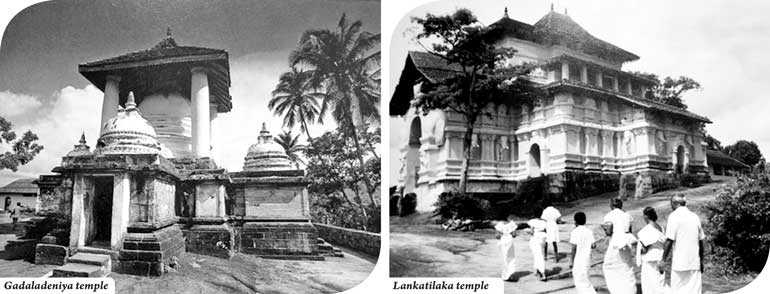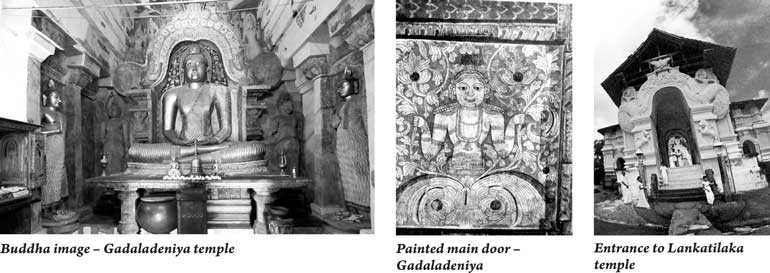Tuesday Dec 23, 2025
Tuesday Dec 23, 2025
Saturday, 9 June 2018 00:00 - - {{hitsCtrl.values.hits}}

By D.C. Ranatunga
Temples situated at Gadaladeniya and Lankatilaka are two popular places of worship close to Kandy. Those going to Kandy to worship the Sri Dalada – Sacred Tooth Relic of the Buddha – often visit these temples as well. They can be reached conveniently by turning off from the Colombo-Kandy road at the 65th milepost.
Visiting the Gadaladeniya temple recently, Minister Sarath Amunugama (among his several other ministerial subjects is Kandyan Heritage), noticed that the murals were deteriorating. It was reported that he drew the attention of officials who accompanied him on the need to attend to them without delay.
This is not the first time that there have been reports of deteriorating state of ancient temples, particularly their centuries-old murals. Most of these temples have been declared as national treasures and the Archaeological Department has been given the responsibility of looking after them. It’s no easy task due to numerous factors. The lack of resources – human, monetary, vehicles to get about, and other needs – is a serious problem.
As for the Gadaladeniya and Lankatilaka temples, both date back to the 14th century. The two temples have been completed in 1344 A.C during the reign of King Bhuvanekabahu IV (1341-51) who ruled from Gampola. However, there is a contrast in the designs in the two temples. While Gadaladeniya shows the Dravidian tradition, Lankatilaka is a continuation of the Polonnaruwa tradition.
Gadalaniya
Gadalaniya vihara is situated on a rock giving a superb view of the country around. It has been built almost exclusively in stone. Professor Senerat Paravavitana records how Dravidian influence was prevalent from the time of King Vijayabahu V (1335-41) onwards:
“This was the time when the neighbouring Tamil country of South India was under Muslim domination, and the numerous artisans there lost patronage. Some of these artisans who were forced to leave their homes appear to have found refuge and employment in Ceylon. Hence the appearance of several Buddhist shrines in Dravidian style built in the Sinhalese kingdom at this time.” – ‘History of Ceylon’ (1961)
Referring to Gadaladeniya temple, he says the building, except for the ‘sikhara’ (the crowning dome), is of stone construction, and the design is Dravidian with some modifications. The ground plan, according to him, deviates somewhat from the Dravidian norm in providing a side shrine for a popular god. Obviously he was referring to a ‘devale’ in the temple premises.
The entrance porch features large stone pillars which support a roof of huge stone slabs. The sitting Buddha image, made of stone and plaster, at the Gadaladeniya temple is 78 ft. in length, 37 ft. in maximum breadth and 40 ft. in height. In front are milk-rice pots which are believed to have been collecting food offerings for several centuries. The jak-wood doors exhibit their original paintings.

Lankatilaka
The Lankatilaka temple is situated less than three miles from Gadaladeniya. A flight of stone steps leads to the picturesque Vihara. Its origin is credited mainly to the efforts and generosity of Sena-Lankadhikara, the great minister of King Bhuvnekabahu IV.
Constructed on an uneven stone surface with bricks, it originally consisted of four storeys but today only the ground floor is being used. Except for the moulded base which is of stone, the building is made of bricks. The shrine has a length of 96 ft. and a breadth of 78 ft. The original height is said to have been 80 ft.
Paranavitana points out that the temple continues the tradition of Polonnaruva, but the design shows Burmese influence. There is an ancient Buddha image of brick and plaster. There are also four devalas to the four guardian deities of the island – Vishnu, Kataragama, Saman and Pattini.
Incidentally, I recall how we did a cycling trip to these temples during the Peradeniya campus days in the mid-1950s. It was good fun.